
While some of us have seen robins come back year after year for 75 or more years, new birds appear each year, and some of us mark them down. Will any of those new birds return two or more years in a row? We can only hope.
Birdwatching has become more popular than bird shooting.
When I was a tot looking out the window at the tree limbs on our front lawn in Mattituck, I remember seeing a pair of male robins duking it out over a female, which had yet to arrive back. One of them left, because a week later the female was back and she and the male robin were making a nest. They didn’t mind me watching, they were so into making their nest and getting on with the job at hand, which was so much more important: the reproduction of the species.
Ten years later, not only were pairs of robins working on nest-building in the yard, they were joined by a pair of cardinals, the first to breed in Mattituck since the Pennys came to live there. Ten years later, there was a pair of mockingbirds.
That’s the way it goes, be assured. Most of the new birds were extending their range northward. And, at the same time, a few birds, like the great black-backed gull, became breeders from the north.
And, lately, it’s been eider ducks breeding in the islands; for example, Fishers Island off Orient Point.
Mallard ducks hardly bred at all on Long Island, but now they are the most common breeding duck, while the Canada goose has become the most common breeding goose. Mute swans from Eurasia have graced Long Island waters since before the 1900s.
Long Island’s wild bird breeding population is always changing. Some Long Island species have become extinct, not only on Long Island but throughout the world. These include passenger pigeons, which Teddy Roosevelt charted in the late 1800s, and the heath hen.
Starting in 1917, the U.S. government has enacted several laws and policies to protect migratory birds, such as egrets, which almost disappeared, and others that were being hunted for their feathers, which were in demand for ladies’ hats and other ornamental products. The egrets slowly recovered and after several years of protection returned to their former migratory flights to breed in the north.
Later, eagles, hawks and owls, never hunted for food but for trophies, received the same degree of protection, and weekend hunting parties for them slowly came to a halt.
When I was a lad, I too shot many different birds with a Red Ryder BB gun, until I knew better. I haven’t killed a bird with a gun since 1955. Today, it seems we kill more people with guns, than birds.
Big-game hunting in Africa and other romantic spots is still practiced but is fading out as elephants, rhinoceroses, lions, tigers, leopards and jaguars are becoming scarcer and scarcer.